Torridge
Explore hidden histories, historic photos, and things you never knew about Torridge from the collections and archives of Historic England.
Discover your local listed buildings and places
Introducing some of Torridge's most historic sites, included in the National Heritage List for England. Some of these captions have been summarised by AI. Click through for the official List entry. Skip this section and go to place by numbers
Northam Chain Home Radar Station
Northam
Second World War radar station, built 1941 and ceased operating in 1944The site includes two transmitter blocks, two receiver blocks, the bases of two receiver tower and four transmitter...
The Cabin
Woolfardisworthy
A former fisherman's store, dating from the mid-C19, with some C20 alterations; used from the 1920s to 1971 as a summer home and studio by artist couple Judith Ackland (1892-1971) and Mary...
Masonic Hall, Caretaker's House at Rear and Garden Walls …
Bideford
Masonic Hall, formerly a large 1692 house, features a caretaker's house, and has been a Freemasons' hall since 1895. It displays historical and architectural significance.
Hembury Castle
Buckland Brewer
Hembury Castle is a slight univallate hillfort with archaeological importance, revealing insights into Iron Age communities in Devon, characterized by its earthwork enclosures and historical...
Church of St Petrock
Petrockstow
Parish church, now redundant; largely rebuilt, except for the C15 tower and reusing some C14 fabric, between 1878 and 1880 by JF Gould. Read the official list entry to find out more.
Lavington United Reformed Church
Bideford
United Reformed Church, 1856-1859 by EM White of Bideford; attached Primary Hall and schoolroom, rebuilt and extended in 1923-1924. Read the official list entry to find out more.
Gull Rock
Off Gull Rock, Lundy Island, Devon
Remains of a 15th- to 16th-century armed vessel wrecked near Gull Rock, Lundy, include cannon and shot; possibly linked to a 1418 Genoese carrack wreck.
Windbury Head camp
Hartland
Windbury Head Hillfort, dating back to the Late Bronze Age and Early Iron Age, offers insights into historical social and economic activities, despite coastal erosion impacts.
Cross ridge dyke on Godborough Castle earthwork NW of Tur…
Northam
A cross dyke known as Goodborough Castle, significant for its archaeological and historical construction, used possibly as territory markers or defensive earthworks.
Embury Beacon camp
Hartland
Embury Beacon is an Iron Age promontory fort located on steep cliffs, offering insights into prehistoric social organization, settlement activities, and defenses like earth ramparts and...
Church of St Mary
Northam
1836-8, by J. Williams. Re-seated 1897-8 to plans by C.E. Smyth-Richards of Barnstaple, and enlarged in 1909, probably by Smyth-Richards or J.J. Smith of Bideford.
Church of St Michael and All Angels
Great Torrington
East end and eastern half of the nave largely Perp (15th or early 16th century), the base of the south transept reportedly with some fabric as early as the 13th century.
HMS Montagu (ex-Montague)
Off Montagu Steps, Shutter Point, Lundy Island, Devon
HMS Montagu (ex-Montague) was a five-year old 14,000 ton battleship that stranded in shallow water off Shutter Point, Lundy Island, without loss of life, on 30 May 1906.The Montagu is the...
1 Grenville Street
Bideford
No. 1 Grenville Street, created in 1934 by Orphoot, Whiting and Lindsay, as a headquarters for the Western Counties Building Society, being an Art Deco re-modelling of an older building.
Iona II
Off Tibbett's Point, Lundy Island, Devon
Wreck of the American paddle steamer Iona II, sunk in 1864 off Lundy in fog, suspected as a Confederate gun-runner. Rediscovered in 1976 with notable historical significance.
Great Torrington Cemetery
Great Torrington
A mid-C19 Burial Board cemetery laid out to the designs of the surveyor to the Great Torrington Burial Board. Read the official list entry to find out more.
Winkleigh War Memorial
Winkleigh
A First World War memorial, designed by Herbert Read. Unveiled September 1921, with later additions for the Second World War. Read the official list entry to find out more.
Rothern Bridge and flanking walls
Frithelstock
An early-C15 bridge, widened in the early-C19. Read the official list entry to find out more.
Frithelstock Priory
Frithelstock
Frithelstock Priory, founded in the 13th century, preserved its layout due to a rural setting and served as a significant monastic site in medieval North Devon.
Hallsannery limekiln
Littleham
The lime kiln near Landcross Bridge is a 19th-century structure with a gothic façade, reflecting the Victorian trend of adding decorative appearances to industrial sites.
31, Bridgeland Street
Bideford
31 Bridgeland Street, Bideford, is a notable 1692-era house remodelled in the early 19th century, with historical architectural details like reeded pilaster-strips and plaster...
27, Bridgeland Street
Bideford
Built for Thomas Morcombe in the 1690s, 27 Bridgeland Street is a historical house with Georgian and Victorian architectural features.
Frithelstock War Memorial
Frithelstock
First World War memorial, with later additions for the Second World War. Read the official list entry to find out more.
Ashwater War Memorial Cross
Ashwater
First World War memorial, 1920, with later additions for the Second World War. Read the official list entry to find out more.
Alwington War Memorial Cross
Alwington
First World War memorial, unveiled 1920, with later additions for the Second World War. Read the official list entry to find out more.
Woodacott Cross War Memorial
Thornbury
First World War memorial by John Freeman and Sons of Penryn, unveiled on 13 November 1927, with further names added after the Second World War. Read the official list entry to find out more.
The Manners Memorial Cross and Peace Park Stone Plaque, C…
Clovelly
First World War memorial cross to Lt John Manners, Grenadier Guards, and memorial plaque marking the gift of the Peace Park as a war memorial. Read the official list entry to find out more.
Holsworthy War Memorial
Holsworthy
First World War memorial, unveiled 1921, with later additions for the Second World War. Read the official list entry to find out more.
Bideford War Memorial Cross
Bideford
First World War memorial cross in granite, unveiled 1921, with later additions for the Second World War. Read the official list entry to find out more.
Petrockstowe War Memorial
Petrockstow
First World War memorial, 1921 with further names added after the Second World War. Read the official list entry to find out more.
Appledore War Memorial
Northam
First and Second World War memorial, erected in 1923, with the names of the Fallen of the Second World War added circa 1949.
K6 telephone kiosk adjacent to the Seagate Hotel
Northam
K6 Telephone Kiosk, designed in 1935 by Giles Gilbert Scott. Read the official list entry to find out more.
Sutcombe War Memorial
Sutcombe
War memorial, erected in 1921. Read the official list entry to find out more.
South Australian
Bristol Channel, NE of Lundy Island.
The South Australian was a composite-hull clipper ship that voyaged annually between London to South Australia for about 20 years.
Montagu Steps
Torridge
The asset comprises the remains of a series of rock-cut steps on Lundy Island.
Northam War Memorial
Northam
A First World War memorial, unveiled in 1920, with later additions for the Second World War. It was moved to its current location between 1980 and 1995.
Alfardisworthy Well
Bradworthy
Holy well surviving as rock cut spring fed basin protected by a mortared rubble built, roofed well house with rectangular doorway facing east. Read the official list entry to find out more.
Explore more
Search for more listed placesTorridge through time
This timeline shows the first period of use for buildings and places on the National Heritage List for England, just one of the details recorded for every list entry. Click around to see how Torridge changes over time. Skip this section and go to aerial photos
Prehistoric Before AD 43
Prehistory covers a million years of human occupation before the Roman invasion and the introduction of writing. Primarily hunter-gatherers of several human species including Neanderthals, the peoples moved across Europe, hunting animals, exchanging ideas and developing complex culture and belief systems including burial rites and astronomical understanding, as at Stonehenge for example.
Early medieval AD 410 to AD 1066
This period, often associated in England with Anglo-Saxons and Vikings, saw a reduction in urban living from the Roman period and increased migration from northern Europe.
Traces of this period can be found in cemeteries, particularly in artefacts and in some of the very early churches, as this period also saw the growth of Christianity in Britain.
Medieval AD 1066 to AD 1540
This period, sometimes known as the Middle Ages, began with the Norman invasion in AD 1066. It saw a significant rise in military and defensive buildings such as castles and earthworks, as well as religious houses dominating a largely agricultural landscape.
The monarchy and Church dominated the period, which also saw the break with the Roman Catholic Church and the English reformation.
Post medieval AD 1540 to AD 1901
The Post-Medieval period brought seismic changes to life in England, with religious reformation leading to the democratization of worship and the destruction of hundreds of religious houses.
In parallel, there was a huge expansion of scientific study and enlightenment that permanently altered the nation's social structure and landscape. Industrialization and mass production lead to wider global trade, emigration, and immigration.
20th century AD 1901 to AD 2000
The 20th century saw an incredible expansion of England's transport networks, with suburban growth shadowing rapid infrastructural expansion. The establishment of state schools, hospitals, and modern technical colleges, with new architectural styles, radically changed the appearance of towns and cities.
Two catastrophic world wars and the 1918 pandemic also brought unprecedented change, altering England's built environment and social structures forever.
Prehistoric Before AD 43
Prehistory covers a million years of human occupation before the Roman invasion and the introduction of writing. Primarily hunter-gatherers of several human species including Neanderthals, the peoples moved across Europe, hunting animals, exchanging ideas and developing complex culture and belief systems including burial rites and astronomical understanding, as at Stonehenge for example.
Early medieval AD 410 to AD 1066
This period, often associated in England with Anglo-Saxons and Vikings, saw a reduction in urban living from the Roman period and increased migration from northern Europe.
Traces of this period can be found in cemeteries, particularly in artefacts and in some of the very early churches, as this period also saw the growth of Christianity in Britain.
Medieval AD 1066 to AD 1540
This period, sometimes known as the Middle Ages, began with the Norman invasion in AD 1066. It saw a significant rise in military and defensive buildings such as castles and earthworks, as well as religious houses dominating a largely agricultural landscape.
The monarchy and Church dominated the period, which also saw the break with the Roman Catholic Church and the English reformation.
Post medieval AD 1540 to AD 1901
The Post-Medieval period brought seismic changes to life in England, with religious reformation leading to the democratization of worship and the destruction of hundreds of religious houses.
In parallel, there was a huge expansion of scientific study and enlightenment that permanently altered the nation's social structure and landscape. Industrialization and mass production lead to wider global trade, emigration, and immigration.
20th century AD 1901 to AD 2000
The 20th century saw an incredible expansion of England's transport networks, with suburban growth shadowing rapid infrastructural expansion. The establishment of state schools, hospitals, and modern technical colleges, with new architectural styles, radically changed the appearance of towns and cities.
Two catastrophic world wars and the 1918 pandemic also brought unprecedented change, altering England's built environment and social structures forever.
Aerial photos of Torridge
Aerial photography helps reveal secrets of England's changing landscapes that are impossible to see from the ground. Skip this section and go to archive images

Bideford
Bideford Bridge, Bideford, 1930
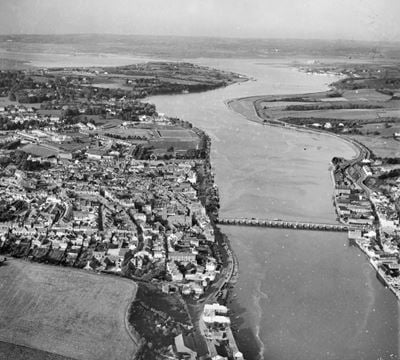
Bideford
Bideford Bridge, the town and River Torridge, Bideford, 1953
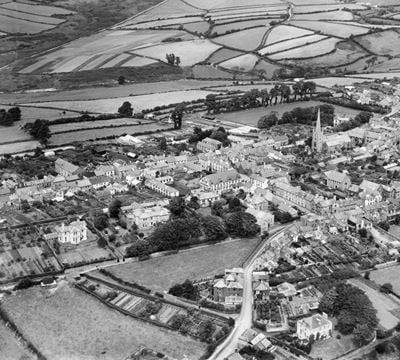
Great Torrington
The town centre, Great Torrington, 1930
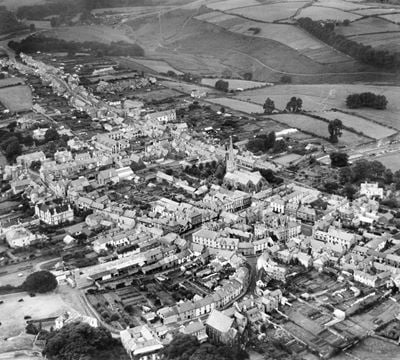
Great Torrington
The town, Great Torrington, 1937
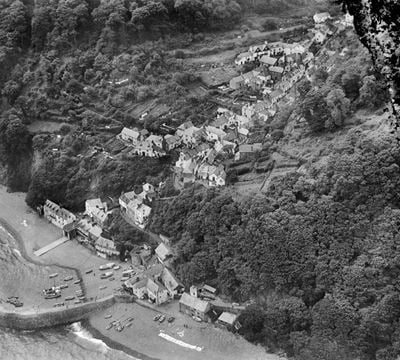
Clovelly
The harbour and village, Clovelly, 1932
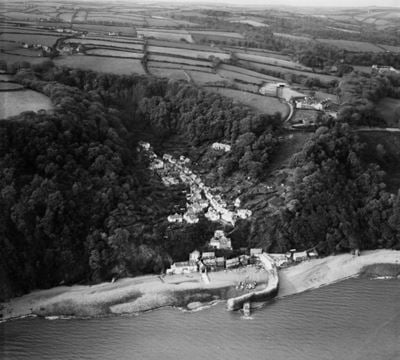
Clovelly
The village, Clovelly, 1948
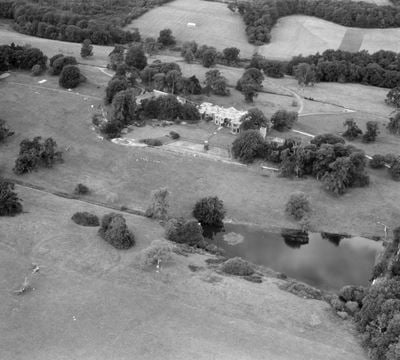
Buckland Filleigh
Buckland House and the Fish Pond, Buckland Filleigh, 1947
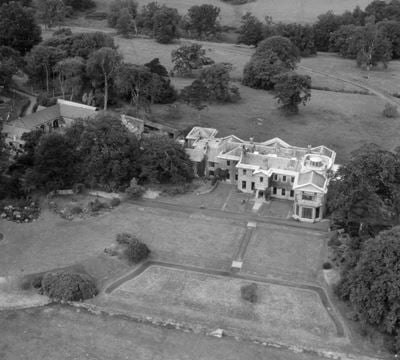
Buckland Filleigh
Buckland House, Buckland Filleigh, 1947

Great Torrington
Torrington Creamery, Great Torrington, 1937
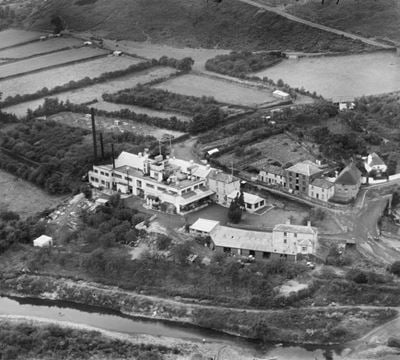
Great Torrington
Torrington Creamery, Great Torrington, 1937
Torridge in the Historic England Archive
The Historic England Archive cares for over 15 million images, dating from the 1850s to the present day. Discover stunning images of Torridge's past. Skip this section and go to stories about heritage
Eric de Mare
Buckland Filleigh, Torridge, Devon
Date created: 1945 - 1980
General view of the Ann Fortescue monument in St Mary's Church in Buckland Filleigh. Ann died in 1815.
John Gay Collection: Counties
Stoke, Torridge, Devon
Date created: 1972
A tree stands in front of St Nectan's Church in Stoke, a Perpendicular style church with an imposing four stage tower measuring 128 feet tall, with...
Alfred Newton and Sons
Torridge, Devon
Date created: 1896 - 1920
GENERAL VIEW LOOKING ACROSS THE FIELDS
Nigel Temple Collection of Postcards of Parks and Gardens
Clovelly Court Park, Torridge, Devon
Date created: 1900 - 1940
VIEW SHOWING ENTRANCE GATES AND PART OF LODGE
Eric de Mare
Torridge, Devon
Date created: 1945 - 1980
Interior view of Cross House in Little Torrington showing a staircase.
John Gay Collection: Counties
Stoke, Torridge, Devon
Date created: 1972
A branch in front of an large, out of focus, St Nectan's Church tower in Stoke. The tower has an embattled parapet with pinnacles at each corner.
Alfred Newton and Sons
Torridge, Devon
Date created: 1896 - 1920
GENERAL VIEW SHOWING MAN FEEDING CHICKENS BESIDE FARM BUILDINGS
Nigel Temple Collection of Postcards of Parks and Gardens
Clovelly Court Park, Torridge, Devon
Date created: 1910 - 1940
EXTERIOR VIEW
Eric de Mare
Torridge, Devon
Date created: 1945 - 1980
Interior view of Cross House in Little Torrington showing a detail of the grand staircase.
John Gay Collection: Counties
Stoke, Torridge, Devon
Date created: 1972
Three Devon Closewool sheep in a field in front of St Nectan's Church in Stoke
Alfred Newton and Sons
Torridge, Devon
Date created: 1896 - 1920
GENERAL COASTAL VIEW AT UNKNOWN LOCATION
Nigel Temple Collection of Postcards of Parks and Gardens
Torridge, Devon
Date created: 1900 - 1920
GENERAL VIEW
Stories about heritage in your local area
Historic England publishes news, blogs, research, videos, and podcasts celebrating England's rich heritage. Discover the stories we have about Torridge. Skip this section and go to education
10 Places That Tell Stories of Isolation
Mentions The Cabin
Isolation and social distancing have shaped our past in many different ways.
Where the Heart is: 5 Landmark LGBTQ+ Homes
Mentions The Cabin
Before 1967, homosexuality was illegal. The privacy of the home provided safety and security for many LGBTQ people.
Volunteers Help Care for Local Archaeology in Torridge, North Devon
Mentions Torridge
Several new projects are underway as part of a scheme to protect and celebrate the remarkable archaeology of the Torridge district in north Devon.
Heritage at Risk in the South West Revealed
Mentions Cross ridge dyke on Godborough Castle earthwork NW of Turner's Wood, Torridge
74 sites have been saved and 43 sites added to the Heritage at Risk Register 2023 in the South West.
132 Nationwide War Memorials Listed Ahead of Armistice Day
Mentions Lavington United Reformed Church
Built in the aftermath of the First World War, the memorials listed since last November are among tens of thousands erected across England.
Places With Queer Histories Listed to Mark 50th Anniversary of the Partial Decriminalisation of Homosexuality
Mentions The Cabin
The two new listings come ahead of the 50th anniversary of the Sexual Offences Act 1967.
Torridge's social history through photos
Over 10,000 images from the Historic England Archive have been specially selected and re-captioned for teachers, students, and anyone who wants to learn more about their local area. Skip this section and go to grant-aided places
Windy Cross, South Street, Great Torrington, Devon
Period: Victorian (1837 - 1901)
There is a 19th century former pump house at the west end of South Street. The Windy Cross sits on top of it.
Windy Cross, South Street, Great Torrington, Devon
View of Clovelly, Devon
Period: Edwardian (1902 - 1913)
A view taken from the beach looking inland towards the building rising from the cliffs.
View of Clovelly, Devon
Town Hall and Public Library, New Road, Bideford, Devon
Period: Victorian (1837 - 1901)
The back part of the Town Hall dates from 1850 and was designed by RD Gould of Barnstaple. The builder was EM White of Bideford.
Town Hall and Public Library, New Road, Bideford, Devon
Tags
The Coastguard, Hartland Point, Devon
Period: World War One (1914 - 1919)
A coastguard keeping watch on the clifftop above the lighthouse. The lighthouse was built in 1874.
Tetcott Barton and Manor Cottage, Tetcott, Devon
Period: Tudor (1485 - 1602)
Tetcott Manor House dates from the 16th and 17th centuries with substantial 18th, 19th and 20th century alterations.
Tetcott Barton and Manor Cottage, Tetcott, Devon
Nos 53 and 54 Clovelly, Devon
Period: Georgian (1714 - 1836)
This pair of cottages stands on the foreshore of the harbour. They probably date from the 18th century and were built from coursed rubble stone.
Nos 53 and 54 Clovelly, Devon
North Hill, Clovelly, Devon
Period: Victorian (1837 - 1901)
A man leading a donkey down the steep cobbled street of North Hill. A young girl in a bonnet is sitting in the doorway of a whitewashed stone building.
North Hill, Clovelly, Devon
Market House, South Street, Great Torrington, Devon
Period: Victorian (1837 - 1901)
The Market House is dated 1842. It is built in classical style with a stucco front and a pediment.
Market House, South Street, Great Torrington, Devon
Discover more
Ready for more local heritage? Take a look at these other places nearby


